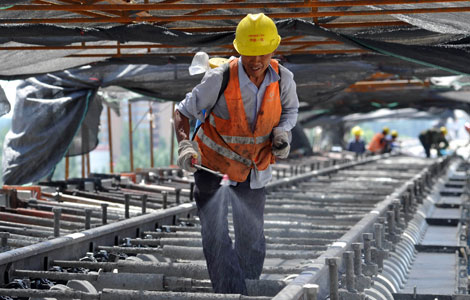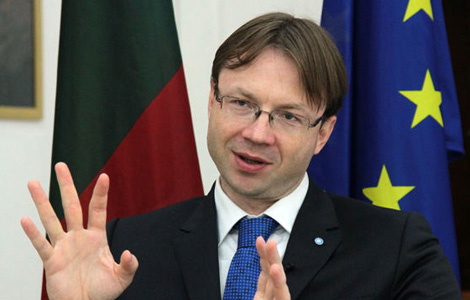Free on his feet
Updated: 2013-07-17 07:11
By Chen Nan (China Daily)
|
||||||||
|
Founding modern dance troupes respectively in Hong Kong, Guangzhou and Beijing, Willy Tsao is considered a modern dance champion in China. Wang Jing / China Daily |
|
Dancers of Hong Kong City Contemporary Dance Company stage the dance show Blind Chance in Beijing. Cheung Chi-wai / For China Daily |
|
Dancers of Beijing Dance LDTX rehearse the dance drama All River Red. Wang Jing / China Daily |
Limelight | Willy Tsao
Willy Tsao had a visceral reaction to the first performance of modern dance he saw decades ago, and has never stopped making the art form his own, Chen Nan reports.
The first time Willy Tsao watched a modern dance show in Hong Kong in the early 1970s, which was performed by an American dance troupe at Hong Kong Arts Festival, he was instantly hooked.
"When I saw the show, I didn't know what they were doing but I wanted to join them immediately and dance like them," he says.
He describes himself, while watching the show, as a resonating wine glass responding as the dancers swayed to the music.
That became the philosophy of how Tsao found like-minded people - they should resonate with modern dance. But he didn't expect his new love for modern dance to become a lifelong passion.
During the 1970s, young people in their 20s like Tsao, who was born in Hong Kong and educated in the United States, considered the city of Hong Kong as boring.
"There was no entertainment. The only show that everyone loved was the annual Miss Hong Kong Pageant," the 58-year-old recalls. "I felt choked in such an environment."
The first group of people he recruited was 12 dancers who had returned from overseas, with whom Tsao founded the first modern dance troupe in Hong Kong, City Contemporary Dance Company, in 1979.
As the only son in his family, Tsao joined his family's printing and property management business in Hong Kong after obtaining his MBA degree, which allowed him to use his own money to run the company and pay the dancers.
Their first show in 1980 only sold 50 tickets and then the troupe offered free shows at 99 middle schools in Hong Kong that year.
"Back then people didn't know what we were doing. They often associated us with night clubs," recalls Tsao. "We were disappointed but never thought about quitting. We knew the problem and tried to fix it."
Thirty years later, the founding of the dance company proves to be a sound decision.
He founded two other dance troupes in Guangzhou and Beijing. The thin man who is considered a modern dance champion in China now heads three dance companies, leading them on tour around the world every year.
"I don't have big ambition. It was just a young man's dream at the beginning and magically it becomes a shared career. When I look back, it's really unbelievable," he says.
In 1991, he helped set up the Guangdong Modern Dance Company, the first professional modern dance company on the Chinese mainland. Later, he was invited to be artistic director of the Beijing Modern Dance Company in 1999 and in 2005 he founded the Beijing Dance LDTX.
Don't force it
He says that he never forces anything.
"The only thing I told the dancers is that your body is free," Tsao says. "In the past, Chinese dancers limited their bodies because they were told that 'Tibetan dance should be like this' and 'Mongolian dance should be like that'. Modern dance gave them a feeling of liberty."
Tsao got a chance to bring his Hong Kong CCDC to Guangzhou in 1980. Dance had been considered a powerful publicity tool to educate the masses on the mainland then. There were only "red" ballets and folk dances.
So Tsao was ready for some bad feedback. However, when the show opened, he saw more than 1,000 people sitting on long wooden benches, twice the venue's capacity.
The night before they left, a young choreographer came to him and asked many questions about their show and how they danced in Hong Kong.
"He told me that all the spectators loved our shows very much but they had to leave early because they were afraid of being seen by the leaders," Tsao recalls. "I saw how curious they were about modern dance and how eager to know the art form."
That experience motivated Tsao to find - and create - modern-dance fans on the Chinese mainland.
Though during the past few years the art form is finding ways to experiment and grow, the focus for Tsao is still finding audiences in China that appreciate it like himself.
"Compared with those big-budget movies and TV shows, modern dance still belongs to a minority taste on the mainland," he says. "But that's OK. We have a stable amount of people who love modern dance and the number is growing steadily."
With modern dance, Tsao wants to express a sense of individualism. He doesn't want to use technology or big stars to attract audiences.
"It's easy to sell tickets. I could invite Lin Hwai-min or Jin Xing. But what's the point? What I want is those who vibrate with modern dance instinctively," he says.
Dance week in Beijing
The annual modern dance weeks held in both Guangzhou and Beijing are where Tsao finds his audiences. Beijing Modern Dance Week, which started on July 14, features dancers around the world, who perform and give lectures and workshops over two weeks.
More than 500 students have applied for the dance courses. Last year, all the shows of the modern dance week at the National Center for the Performing Arts were sold out.
Modern dance is enjoying a big boom, Tsao says, because Chinese audiences have started to realize the importance of personal voice.
"Especially since the 2008 Beijing Olympic Games, Chinese people have become confident and open to different art forms," he says. "When it comes to modern dance, it is not a Western art form. It is a voice of any society when it comes to the modern era."
Popular TV dance shows, such as Let's Shake It and So You Think You Can Dance, also help expose a billion-plus Chinese people to modern dance. However, that's not exactly what the modern dance pioneer anticipated.
"Modern dance and competitions are not compatible," Tsao says. "Imagine: A dancer has to attract all the attention in two minutes, and what the audiences see is just fake emotion and moves catching eye balls."
In Beijing, Guangzhou and Hong Kong, Tsao says, the most enjoyable thing is watching his performers dancing. To spend more time with his dancers, he sold his house and car in Beijing and lives in his office at Beijing Dance LDTX.
In the theater of Beijing Dance LDTX recently, he was watching the rehearsal of All River Red, a powerful dance drama adapted from Stravinsky's Rite of Spring. It has been staged more than 400 times since its birth in 2002 and will be performed in the coming modern dance week.
One thing Tsao would never do is to make dances "with Chinese characteristics".
"People would ask 'Why not add some Chinese elements, like the dragon?' I refuse to play that game. Otherwise, we become either a copycat of the West or we become traditionalists," he says. "The essence of modern dance is freedom. When an artist has total freedom to do whatever he wants, this is modern dance."
(China Daily USA 07/17/2013 page9)
Most Viewed
Editor's Picks

|

|

|

|

|

|
Today's Top News
US attorney general questions gun law
China's US T-bill holdings hit record in May
iPhone death probed by Apple
Spring agency flourishes with travelers to US
Chinese textile industry aims for 'green'
GM's sales up 4% on strong US, China demand
New visa law offers lifeline to foreigners
Asiana passengers sue Boeing
US Weekly

|

|
















